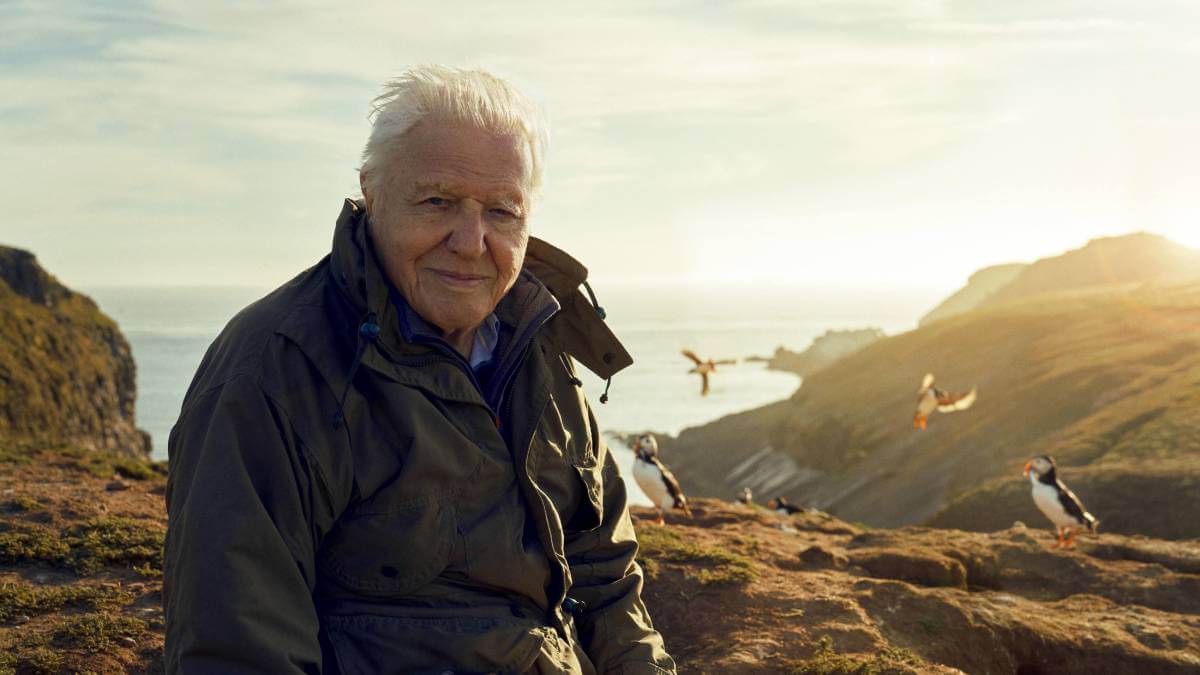Standing, windswept, on the edge of Old Harry Rocks on Dorset’s Isle of Purbeck, Sir David Attenborough gazes at the landscape below him.
“In my long life, I’ve been lucky enough to travel to almost every part of the globe and gaze upon some of its most beautiful and dramatic sights,” he muses. “But I can assure you that nature in these islands – if you know where to look – can be just as dramatic and spectacular as anything that I’ve seen elsewhere.”
A rare outing for the 96-year-old veteran wildlife presenter, who’s made the decision to cease travelling, the scene opens the five-part series Wild Isles. Billed as the most ambitious and epic documentary series about wildlife in the UK, it features scenes of orcas stalking seals in kelp channels, bluefin tuna chasing baitballs and 15cm-long leeches hunting toadlets – a scene series producer Alastair Fothergill predicts will shock viewers as much as the famous racer snakes scene in Planet Earth II.
“There are lots of big spectacles in this country that people don’t know about,” says Mr Fothergill. “We have extraordinary slugs with penises the length of their own body, and an amazing bee that lays its eggs in a snail shell and makes a wigwam from twigs to protect it.”
Along with showcasing our diverse geology and “amazing variety of landscapes”, Mr Fothergill hopes the series will inspire people to enjoy and protect the wildlife of the UK.
Here’s how to spot some of the wildlife featured in the series.
Orcas in the Shetlands

Regarded as one of the best places in the British Isles to spot wildlife, the Shetlands – an archipelago lying between Orkney, the Faroe Islands and Norway – is annually visited by killer whales. Join a cruise to track their movements and perhaps even catch them hunting seals. Northern Light Cruising offers nine-night cruises between Inverness and Shetland, joined by wildlife photographer Chris Gomersall and ecologist David Lambie. Along with observing wildlife on the water, there are also land-based activities.
How: A nine-night Northern Isles cruise costs from $5325pp, excluding flights. Departs 30 June from Inverness, or 10 July from Shetland.
Seals in the Scilly Isles
View this post on Instagram
On land, they look like blubbery sausages, but once in the water, seals move with balletic grace. See them in action offshore from the Scilly Isles, off England’s southwest coast. The uninhabited Eastern Isles have some of the most active populations of Atlantic grey seals, along with a variety of seabirds. As part of a tailormade five-day Isles of Scilly Discovery trip, Wexas can arrange short half-day cruises, operated locally, to access hidden coves and unspoilt coastlines.
How: From $1600pp, Wexas offers B&B accommodation and ferry travel from Penzance.
Red squirrels in Scotland
View this post on Instagram
Like something straight out of a Disney movie, the red squirrels native to the UK are endearingly cute. While numbers have dropped significantly in many parts of the country, there’s still a healthy population in Scotland. See them at Abernethy National Nature Reserve as part of the small group Wildlife Of The Scottish Highlands & Coast tour with Gane and Marshall. Other highlights include spotting golden eagles on the Isle of Mull; kayaking among seals and sea otters in the Sound of Arisaig; and watching dolphins and porpoises in the Moray Firth.
How: Gane and Marshall offers six-night escorted tours from $3700pp, including full-board accommodation and transport to and from Inverness. Various departures from 29 April.
Red deer in Killarney National Park, Ireland

Fiery by both name and nature, red deer have a temper during rutting season. Stags can be seen battling from late September until early November in Killarney National Park in County Kerry, where Ireland’s last surviving indigenous herd has resided since Neolithic times. Beyond the fierce battles, however, the scenery is even more dramatic. The Emerald Isle’s oldest protected wilderness features several walking trails winding through lakes, glens, waterfalls, and forests, against a mountain backdrop.
How: Macs Adventure offers a five-day Kerry Way short break from $840pp, including B&B accommodation, baggage transfers and GPS navigation map. Transport to and from the start point is extra.
Red knots at Snettisham, Norfolk
View this post on Instagram
Seeing any animal in large numbers is heart-stopping. Every summer and autumn, 100,000 knots gather on the mudflats at The Wash in Norfolk, proof spectacles on this scale do happen in the UK. Spring tides send them skyward, where they create patterns similar to the murmurations performed by starlings. Wildlife photographer Paul Goldstein arranges short weekend breaks timed to coincide with the phenomenon, with accommodation in a family-run riverside farmhouse.
How: Exodus offers three days half-board from $1070pp, own car required. Various departures in October.
Which of these animals would you most like to see in the wild? Are you a fan of Sir David Attenborough? Let us know in the comments section below.
Also read: Sir David Attenborough on the world’s plant life: ‘We better jolly well care for it’
– With PA

